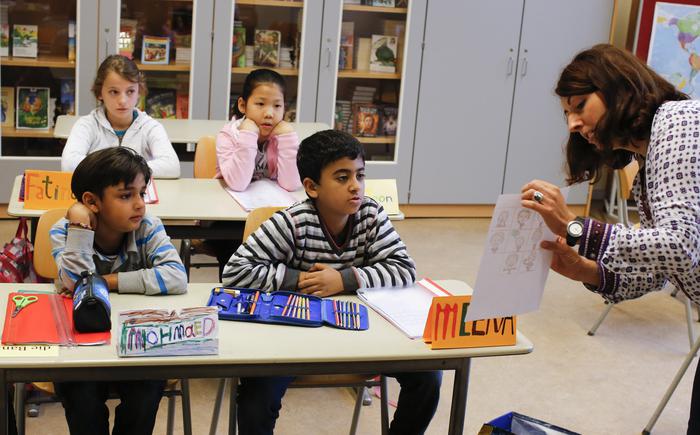New teaching model
1.Acompletenewteachingmodelshouldincludethefollowingfivefactors:
(1)Theoreticalbasis:referstotheteachingtheoryorteachingideaonwhichtheteachingmodelisbased.
(2)Teachinggoal:Referstotheteachingresultthattheteachingmodelcanachieve,thatis,whatkindofeffectitcanproduceonthelearner.Differentteachingmodelsarealwaysdesignedforacertainteachinggoal,ratherthanbeingcompletelyuniversal.
(3)Operationprocedure:Referstothestepsofteachingactivitiesandthespecificoperationmethodofeachstep.Ofcourse,thisprocedureisnotstatic.
(4)Realizationconditions(meansandstrategies):Inordertogivefullplaytotheeffectivenessoftheteachingmode,teachersmustoptimizethecombinationofvariousteachingconditionswhenusingtheteachingmode,followcertainprinciplesandadoptcertainMethodsandtechniques.
(5)Evaluation:Sinceeachmodelhasitsownapplicableconditionsandteachingobjectives,theevaluationcriteriaandmethodswillalsobedifferent.
2.Typesofnewteachingmodels
Duetodifferentteachingideasortheoriesbasedonteachingpractice,differentlearningcontentandgoals,theformsandprocessesofteachingpracticeactivitiesareboundtobedifferent.Therebyformingdifferentteachingmodes.Fromdifferentperspectives,theclassificationmethodsofteachingmodelsarealsodifferent.Forexample,thedual-centeredteachingmodelof"teacher-centered","student-centered"and"teacher-led,student-based"weoftensayisclassifiedaccordingtothestructuralrelationshipoftheteachingsystem;classteaching,groupteachingTeachingandindividualizedteachingareclassifiedaccordingtothedifferentformsofteachingorganization;teachingbasedon“hand-on”,teachingbasedonmind-on,andteachingbasedonreality-onareclassifiedfromItisclassifiedaccordingtothedifferentteachingobjectives.Hereareseveralclassificationmethodsthataremoreusefulforeducationaltechnologyresearch.
(1)Newteachingmodelsclassifiedaccordingtothetheoreticalbasisoflearning
Intheeducationaltechnologyfield,differentclassificationmethodsaccordingtothetheoreticalbasisoflearningarefrequentlycited,andtheteachingmodelsaredividedintofiveGroups:
①Behaviormodificationmode.Mainlybasedonbehaviorallearningtheory,emphasizingtheimpactofenvironmentalstimulionlearners'behavioralresults.SuchasSkinner'soperationalconditioningandreinforcementtheory,Bandura'sobservationalimitationlearningandbehaviormodificationtheory.Itsteachingmethodsincludeprogramteaching,masteringlearningmethods,simulation,computerdrillsandexercises,etc.Especiallysuitableforknowledgeandskilltraining.
②Socialinteractionmode.Mainlybasedonthetheoryofsocialinteraction,emphasizingthemutualinfluenceandsocialconnectionbetweenteachersandstudents,studentsandstudents.SuchasBandura'ssociallearningtheory,Vygoski'stheoryofculturalandhistoricaldevelopment,etc.Itsteachingmethodsincludecooperativelearning,groupdiscussion,roleplaying,andsocialsciencesurveys.Especiallysuitableforcultivatinginterpersonalcommunicationskills.
③Thepersonalmodelofpersonalitydevelopment.Mainlybasedonthetheoryofindividualizedteachingandhumanisticteachingideas,emphasizetheindividual'ssubjectiveinitiativeinteaching,andinsistonindividualizedteaching.Itsteachingmethodsincludenon-guidedteaching,heuristicteaching,anddiscussionteachingofseekingcommongroundwhilereservingdifferences.Itissuitableforpersonalitycultivation,differentthinking,independentlearningandproblem-solvingability.
④Informationprocessingmode.Mainlybasedontheinformationprocessingtheoryofcognitivism,teachingisregardedasacreativeinformationprocessingprocess.Itsteachingmethodsincludetheinquirymethodofconceptacquisition,exampleteaching,meaningfulacceptancelearning,discoverylearning,andinvestigationmethods.Usedtoimprovelogicalthinkingandcriticalthinkingskills.

⑤Constructivismmodel.Itismainlybasedontheconstructivistlearningtheory,emphasizingthatlearnersconstructtheirunderstandingofthingsintheirownwaywiththehelpofothers.Itsteachingmethodsincludesituationalmethod,discoverymethod,problem-basedlearning,groupresearch,cooperativelearning,etc.Itisespeciallysuitableforthestudyof"badstructure"fieldsandadvancedknowledgeandthecultivationofthespiritofscientificresearch.
(2)Anewteachingmodelbasedontheclassificationofteachingtheory
Thefollowingtableliststhecharacteristicsoffivesucheducationmodelsandtheirbasiceducationprocess.
ModelNameModelFeaturesBasicEducationalProcess
Q&AModelC1QuestionsandAnswersforteachersandstudents,inspiringteachingquestions→Thinking→Q&A→Exercise→Evaluation
TeachingmodeC2Typeteachercenter,systemicteaching→understanding→consolidation→application→inspection
Self-studymodeC3-typestudentcenter,self-studycounseling,self-study→question-solving→practice→self-evaluation→feedback
cooperativemodeC4typemutualteachingandmutuallearning,cooperativeeducationinduction→learning→discussion→practice→evaluation
ResearchmodeC5typequestioncenter,thesisdefensequestion→exploration→report→reply→evaluation
Thefivemodelsofteachingtheoryareasequenceofdevelopment.FromC1toC5,students’learninginitiativegraduallyincreased,reflectingthelawof“teachingisfornotteaching”,andfromC5toC1,teachers’dominancegraduallyincreased,reflectingthelawof“teachingisfordevelopment”.
(3)Classificationofinformatizationteachingmodelsfromtheperspectiveofphilosophy
ProfessorZhuZhitingstudiedinformatizationteachingmodelsfromtheperspectiveofeducationalphilosophy,proposedaclassificationframeworkforteachingmodels,andbelievedthatteachingThedifferenceinmodesisessentiallyaculturaldifference.Theculturaldifferencesinteachingmodescanbeinvestigatedfromtwodimensions:epistemologyandvalues.Fromtheperspectiveofepistemology,therearetwoopposingviews:objectivismandconstructivism;fromtheperspectiveofvalues,therearealsotwoopposingviews:individualismandcollectivism.IndividualismisthecoreofthevaluesofWesterncountries,especiallytheUnitedStates,BritainandotherWesterncountries.Itismanifestedinthegeneraladoptionofindividualizedteachingplansineducationtoencourageindividualcompetitionamongstudents.IndividualizedCAIiscompletelyconsistentwiththisvalue.CollectivistvaluesoccupiesadominantpositioninsocialistcountriesandmanyEasterncountries.Ineducation,itismanifestedintheuniversaladoptionofcollectivizedteachingplanstoencouragestudentstohelpeachotherandpromotethespiritofteamwork.
Regardingvaluesandepistemologyastwobasicvariablesforinvestigatingthedifferencesineducationandculture,andtreatingeachvariableasacontinuum,atwo-dimensionalclassificationmodelofeducationandculturecanbeobtained.FourdifferenttypesofeducationCulture:①Individualism-Objectivism;②Individualism-Constructivism;③Collectivism-Objectivism;④Collectivism-Constructivism.
Foraspecificeducationalculture,itcanbeinacertainpositiononthisplane.Thisclassificationmodelcanalsohelpcharacterizetheevolutionofeducationalculture.Forexample,theeducationalandculturaltraditionsintheUnitedStatesarebasicallyformI,andarenowmigratingtoformII.Japan’seducationalcultureisaverytypicaltypeIIIculture,andmycountry’seducationalcultureisalsobiasedtowardsthetypeIIIculturebyitsnature.Variousteachingmethodsfromthetraditionaltothelatestdevelopmentcanfindtheircorrespondingpositionsinthisclassificationmodel.
Tounderstandtheculturalorientationoftheteachingmodelfromtheperspectiveofobjectivism-constructivism.Theteachingmodewithobjectivismtendstobegenerallysuitableforthelearningofbasicknowledgeinthe"well-structured"field.Thelearningresultscanbe"converged"(studentscaneasilyreachaconsensus),andusuallyshow"neartransfer"intermsofknowledgeapplicationability."Becauseitadoptsadirectteachingform,itusuallyhasahigherteachingefficiency;theteachingsystemwithaconstructivisttendencyismoresuitableforthelearningof"badstructure"fieldsandadvancedknowledge,andthelearningresultsareoften"divergent"(It’snoteasyforstudentstoreachaconsensus),intermsofknowledgeapplicationability,itisusuallymanifestedas“fartransfer”,becausemostofthemadoptdiscoveryanddiscussionteachingmethods,whicharegenerallytime-consuming,andthemeaningistofocusonstudents’innovationability.actualeffect.RegardlessofChinaandforeigncountries,traditionaleducationalculturetendstobeobjectivist,buteducationalresearchinmanyWesterncountrieshasbeguntoturnitsattentiontoconstructivism.Thisisinlinewiththetendencyofscientificresearchintheworldtobegintoimpactthoseinferiorstructuresanddivergentfields.Itisconsistent,andmoderninformationtechnologyprovidesastrongguaranteeforconstructivistlearning.
Latest: HTTP
Next: 11th century








